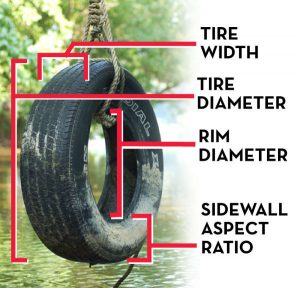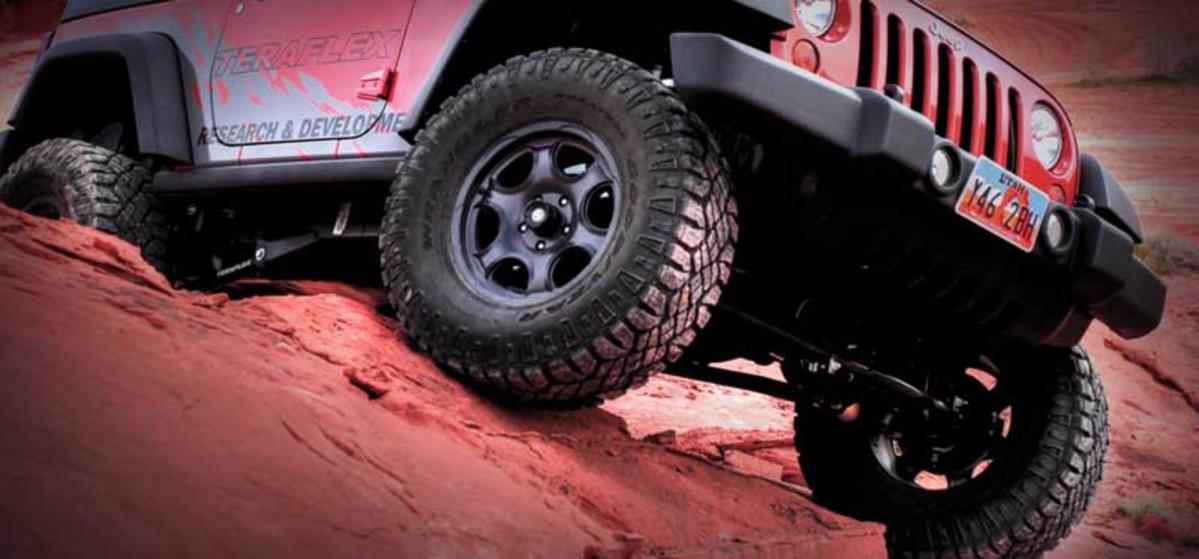"What size tires should I get for my Jeep?"
It's one of the most common questions asked. You're excited and also overwhelmed by this important decision, and we’re here to help you through the process. As you know, there is a lot to consider.
The type of tire you choose will affect gas mileage, wear and tear on parts, and of course, your wallet. Many owners begin with dreams and visions of 40” tires and 6” lifts. A perfect idea if you’re a rock crawler and use the Jeep strictly for off-road use. In reality, however, most of the time your spouse has to commute in your Jeep 50 miles daily on the freeway. If you’ve got 40” tires, the gas mileage — combined with the wear and tear of commuting — will get expensive.
A range of options exists. Here we’ll discuss a few examples from the JK Wrangler/Unlimited’s stock 255mm width tire up to a large 40” tire. You can actually go larger than 40” — if you want to go monster truck.
Metric Tire Sizes
 A tire measurement numbering system can be found on the inside wall of the tire. For example, on a metric tire, you might read 255/75R17. The first set of numbers (255) refers to the tire width in millimeters.
A tire measurement numbering system can be found on the inside wall of the tire. For example, on a metric tire, you might read 255/75R17. The first set of numbers (255) refers to the tire width in millimeters.
The next set of numbers (75) is the sidewall aspect ratio, a percentage that tells us how tall and how narrow the sidewall of the tire is in millimeters. So, in the case of our example, the tire’s sidewall height is 75% of its tread width. To make this easy, let’s set a baseline of 255mm as the tire width. If it’s a 60 series tire, the sidewall will be shorter, stiffer, and more resistant to cornering forces. If it’s a 75 series tire, like our example above, it will have a taller sidewall, be more prone to rolling under in a corner, and provide more cushion on a bump due to more material.
The next part of the number system describes the tire’s internal construction. In this case, we have an R, telling us that this tire is a radial tire, or was made using radial construction, which is the very most common type these days.
The last two digits in the system (17) represent the tire’s rim diameter in inches.
To sum up, a stock size tire is:
Tire Width: |
255mm |
Sidewall Aspect Ratio: |
75% |
Internal Construction: |
Radial |
Rim Diameter: |
17 inches |
33” Tires
JK models have just enough wheel clearance inside the fender that a 33” tire can actually be used without a single modification. However, if you’re taking it off-road, some changes are necessary to avoid the risk of rubbing.
The other tire measurement number system is that of inches, instead of millimeters. For example, 33x12.50R15. In this case, the 33 refers to the full-length diameter of the tire in inches, from the ground to the tip-top of the tire. The next number (12.50) will be the width of the tire in inches. The last number (15) is, again, the rim's diameter in inches.
To sum up:
Tire Diameter: |
33 inches |
Tire Width: |
12.50 inches |
Internal Construction: |
Radial |
Rim Diameter: |
15 inches |

This tire size works well for someone who likes off-road, hitting some trail runs on occasional weekends, but uses their Jeep primarily on the street. This will have minimal effect on your gas mileage and your ride. You’ll be able to use this tire with at least a simple JK: 2.5” Performance Spacer Lift Kit (w/ Shock Extensions or w/ 9550 VSS Twin Tube Shocks). It will offer a nice look but still have some good street manners.
35" Tires
Next up is the 35” tire. These are some of the most popular tires on JK models. This height requires a lift kit, but you can get by smoothly with a 2.5” Lift or 3" Lift. This gives better ground clearance with minimal effect on your drivability and handles very nicely on the road.
37" Tires
Then we have the 37” tire. An example would be 37x12.50R17. The 37” tire basically moves you up to the next level — now you’re looking at gear changes to recover from power and fuel mileage lost due to larger, heavier tires. Despite these detriments, when you get off-road, these will perform with excellence. This size will require a 4” Lift for off-road use. You can risk a 3” lift, but it’ll be tight.
38" Tires
Next up is Dennis’ favorite, the 38”. Not only does it provide an extra inch in height, but it goes up to 14.50” in tire width (38x14.50R17). There are two additional inches in tire width compared to the 37” tire. Though 38" tires are hard to turn, and you’ll need some horsepower behind them.
40" Tires
Last but not least is the 40”. This tire is hard to beat off-road. The extra height achieved when climbing a ledge allows for greater ease, turning some obstacles into simple non-events. When considering clearance issues, you’ll need at least a 6” Lift unless you do some major body modifications (probably including a loss of sheet metal) to make them fit. The 40” tires are actually 13.50 wide (40x13.50R17), so they’re an inch narrower than the 38”, but you’re still gaining a couple of inches in height.
Somewhere in the galaxy lies a set of tires destined exactly for you and your lifestyle.

